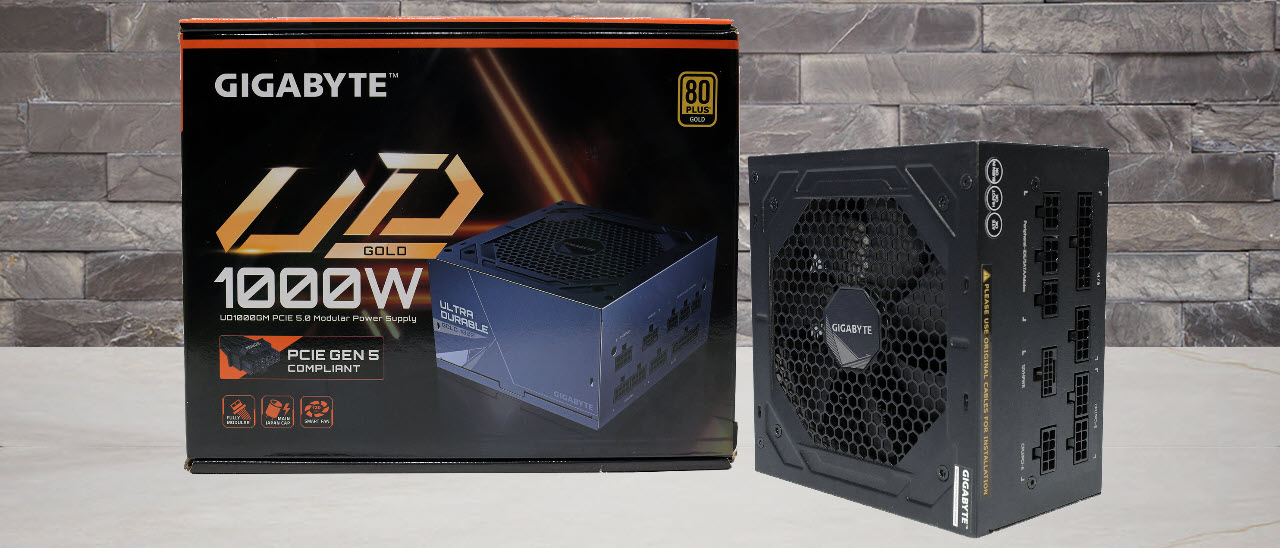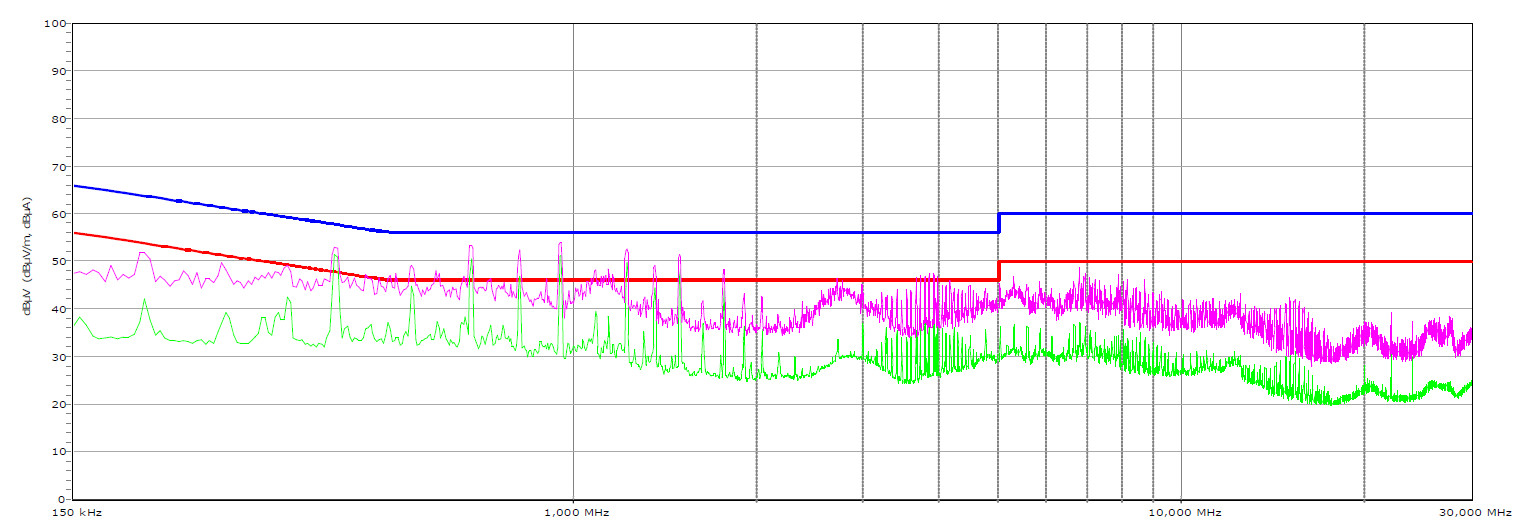Why you can trust Tom's Hardware
Advanced Transient Response Tests
For details about our transient response testing, please click here.
In the real world, power supplies are always working with loads that change. It's of immense importance, then, for the PSU to keep its rails within the ATX specification's defined ranges. The smaller the deviations, the more stable your PC will be with less stress applied to its components.
We should note that the ATX spec requires capacitive loading during the transient rests, but in our methodology, we also choose to apply a worst case scenario with no additional capacitance on the rails.
Advanced Transient Response at 20% – 20ms
| Voltage | Before | After | Change | Pass/Fail |
| 12V | 12.020V | 11.837V | 1.52% | Pass |
| 5V | 5.078V | 4.962V | 2.29% | Pass |
| 3.3V | 3.329V | 3.185V | 4.32% | Pass |
| 5VSB | 5.029V | 4.987V | 0.84% | Pass |
Advanced Transient Response at 20% – 10ms
| Voltage | Before | After | Change | Pass/Fail |
| 12V | 12.023V | 11.786V | 1.97% | Pass |
| 5V | 5.078V | 4.960V | 2.32% | Pass |
| 3.3V | 3.329V | 3.191V | 4.16% | Pass |
| 5VSB | 5.029V | 4.977V | 1.03% | Pass |
Advanced Transient Response at 20% – 1ms
| Voltage | Before | After | Change | Pass/Fail |
| 12V | 12.023V | 11.789V | 1.94% | Pass |
| 5V | 5.077V | 4.995V | 1.61% | Pass |
| 3.3V | 3.329V | 3.176V | 4.60% | Pass |
| 5VSB | 5.029V | 4.972V | 1.14% | Pass |
Advanced Transient Response at 50% – 20ms
| Voltage | Before | After | Change | Pass/Fail |
| 12V | 12.003V | 11.912V | 0.76% | Pass |
| 5V | 5.056V | 4.940V | 2.29% | Pass |
| 3.3V | 3.309V | 3.156V | 4.64% | Pass |
| 5VSB | 5.008V | 4.964V | 0.89% | Pass |
Advanced Transient Response at 50% – 10ms
| Voltage | Before | After | Change | Pass/Fail |
| 12V | 12.005V | 11.906V | 0.82% | Pass |
| 5V | 5.056V | 4.936V | 2.38% | Pass |
| 3.3V | 3.309V | 3.168V | 4.27% | Pass |
| 5VSB | 5.008V | 4.954V | 1.08% | Pass |
Advanced Transient Response at 50% – 1ms
| Voltage | Before | After | Change | Pass/Fail |
| 12V | 12.005V | 11.906V | 0.83% | Pass |
| 5V | 5.056V | 4.952V | 2.06% | Pass |
| 3.3V | 3.309V | 3.162V | 4.44% | Pass |
| 5VSB | 5.008V | 4.947V | 1.22% | Pass |
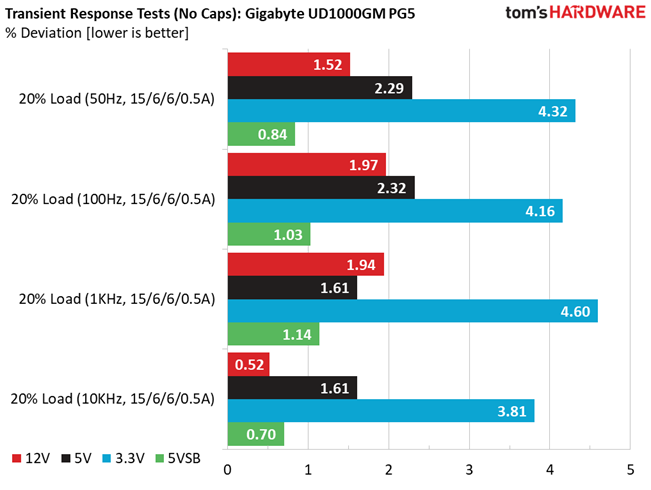



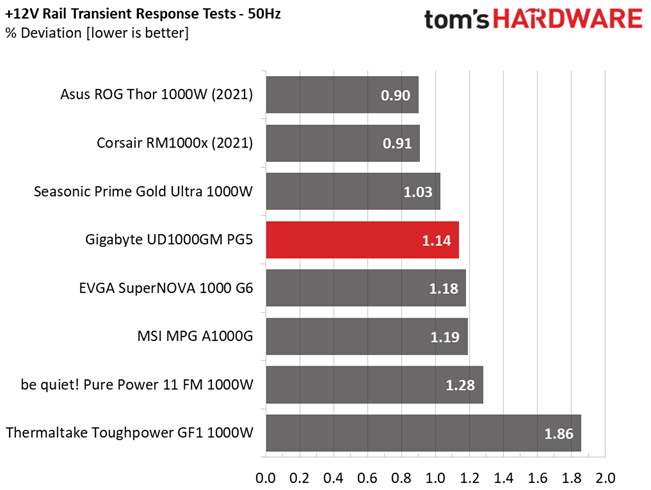



With our usual transient loads, the 12V and 5V rails perform well. On the contrary, the minor rails have high voltage drops. Still, they pass all tests.
Advanced Transient Response Tests - ATX v3.0
The Intel ATX v3.0 spec, besides the 12VHPWR connector, also introduced new requirements for transient response testing. You can read more on our ATX v3.0 analysis. So we have to conduct extra transient response tests in the new generation PSUs to check if they meet the ATX v3.0 requirements.




With the extra capacitance applied, in the 200% transient test, the 12V rail doesn't drop below 11.04V on the PCIe connectors, and the same goes for the lighter 120% transient test. The minor rails are also within the allowed 5% deviation, with the extra capacitance.
We couldn't run the 180% and 160% transient tests, where the transient load is applied for 1ms and 10ms, respectively, since the PSU kept on shutting down with or without the extra capacitance. This is an issue that shouldn't be happening, according to the ATX v3.0 requirements, but since this is the first PSU with PCIe 5.0 compatibility that we evaluate, we will wait to have more data to draw a solid conclusion.
Get Tom's Hardware's best news and in-depth reviews, straight to your inbox.
Turn-On Transient Tests
In the next set of tests, we measure the PSU's response in simpler transient load scenarios—during its power-on phase. Ideally, we don't want to see any voltage overshoots or spikes since those put a lot of stress on the DC-DC converters of installed components.



We noticed a small step and a tiny voltage overshoot at 5VSB. During the last 12V test, there is also a small voltage step close to the slope's peak. All in all, the performance is good enough in these tests.
Power Supply Timing Tests
There are several signals generated by the power supply, which need to be within specified, by the ATX spec, ranges. If they are not, there can be compatibility issues with other system parts, especially mainboards. From year 2020, the PSU's Power-on time (T1) has to be lower than 150ms and the PWR_OK delay (T3) from 100 to 150ms, to be compatible with the Alternative Sleep Mode.
| T1 (Power-on time) & T3 (PWR_OK delay) | ||
|---|---|---|
| Load | T1 | T3 |
| 20% | 58ms | 136ms |
| 100% | 58ms | 136ms |

PSU Timing Charts

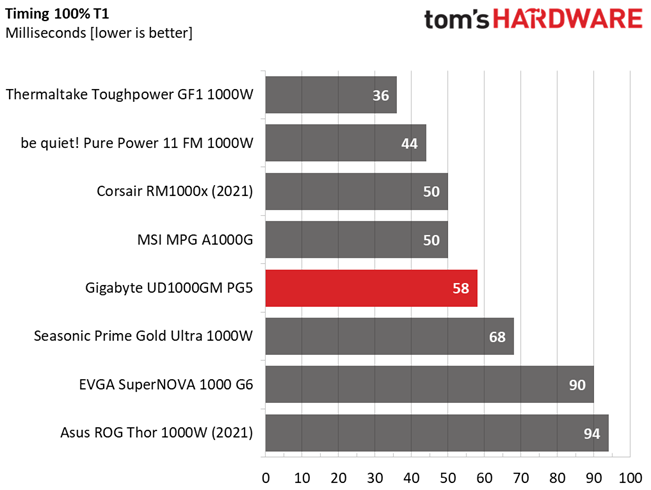

The PWR_OK delay is within the 100-150ms region, so the PSU supports the alternative sleep mode recommended by the ATX spec.
Ripple Measurements
Ripple represents the AC fluctuations (periodic) and noise (random) found in the PSU's DC rails. This phenomenon significantly decreases the capacitors' lifespan because it causes them to run hotter. A 10-degree Celsius increase can cut into a cap's useful life by 50%. Ripple also plays an important role in overall system stability, especially when overclocking is involved.
The ripple limits, according to the ATX specification, are 120mV (+12V) and 50mV (5V, 3.3V, and 5VSB).
| Test | 12V | 5V | 3.3V | 5VSB | Pass/Fail |
| 10% Load | 8.0 mV | 10.3 mV | 11.5 mV | 4.9 mV | Pass |
| 20% Load | 18.2 mV | 10.4 mV | 10.8 mV | 5.5 mV | Pass |
| 30% Load | 10.8 mV | 10.2 mV | 11.2 mV | 6.1 mV | Pass |
| 40% Load | 10.2 mV | 11.3 mV | 11.9 mV | 7.1 mV | Pass |
| 50% Load | 10.4 mV | 12.0 mV | 16.0 mV | 11.3 mV | Pass |
| 60% Load | 10.7 mV | 12.8 mV | 12.5 mV | 8.8 mV | Pass |
| 70% Load | 10.5 mV | 13.5 mV | 12.6 mV | 14.5 mV | Pass |
| 80% Load | 11.0 mV | 13.6 mV | 14.1 mV | 12.5 mV | Pass |
| 90% Load | 11.3 mV | 13.2 mV | 13.8 mV | 11.8 mV | Pass |
| 100% Load | 15.2 mV | 14.7 mV | 15.9 mV | 15.3 mV | Pass |
| 110% Load | 15.5 mV | 17.2 mV | 18.1 mV | 15.3 mV | Pass |
| Crossload 1 | 9.4 mV | 12.1 mV | 12.6 mV | 6.2 mV | Pass |
| Crossload 2 | 8.0 mV | 11.0 mV | 11.3 mV | 5.6 mV | Pass |
| Crossload 3 | 9.0 mV | 10.0 mV | 13.3 mV | 5.4 mV | Pass |
| Crossload 4 | 15.2 mV | 13.8 mV | 14.3 mV | 13.8 mV | Pass |




Ripple suppression is not bad or mediocre, but the competition is notably better at 12V and 5V.
Ripple At Full Load


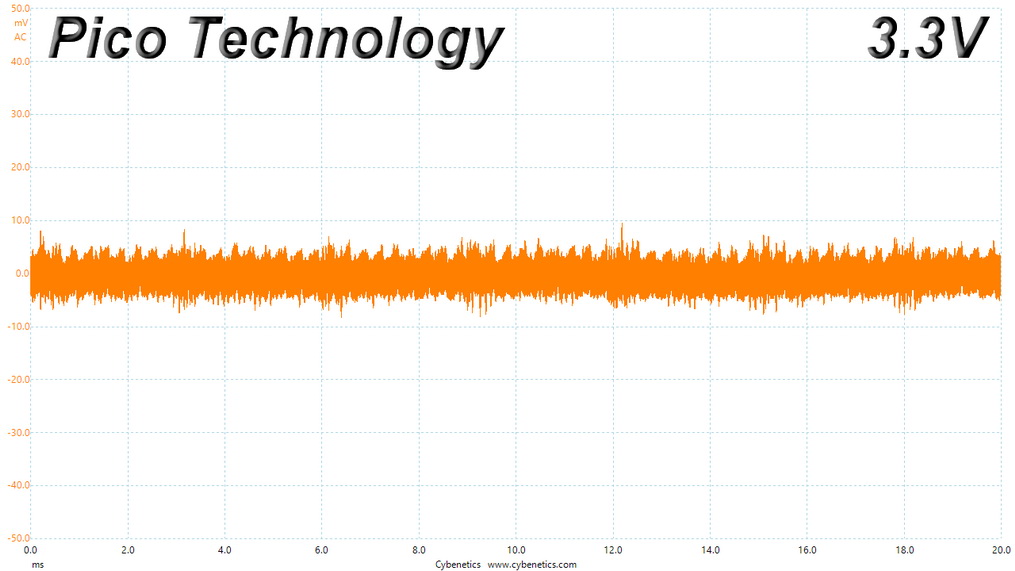

Ripple At 110% Load


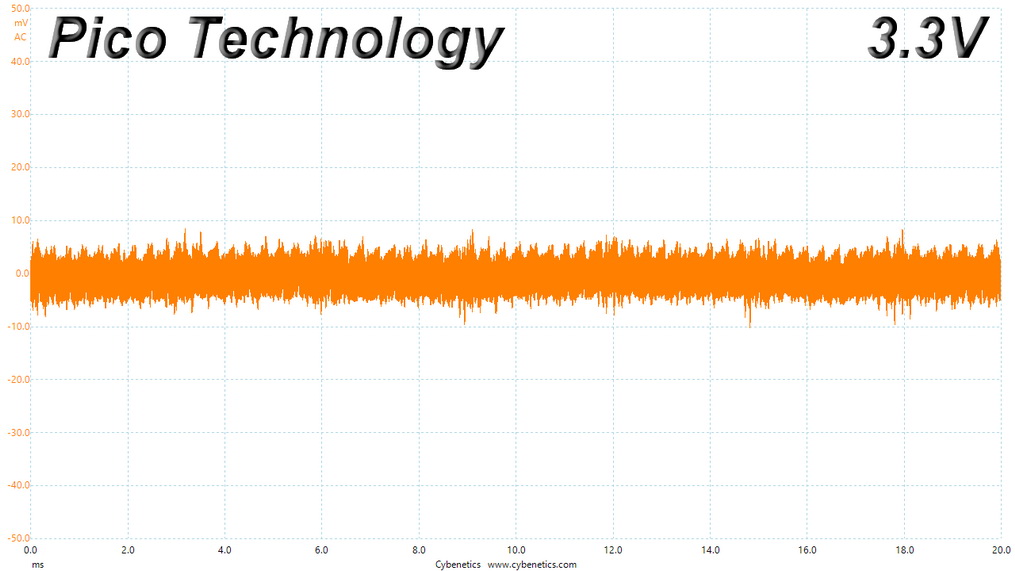

Ripple At Cross-Load 1
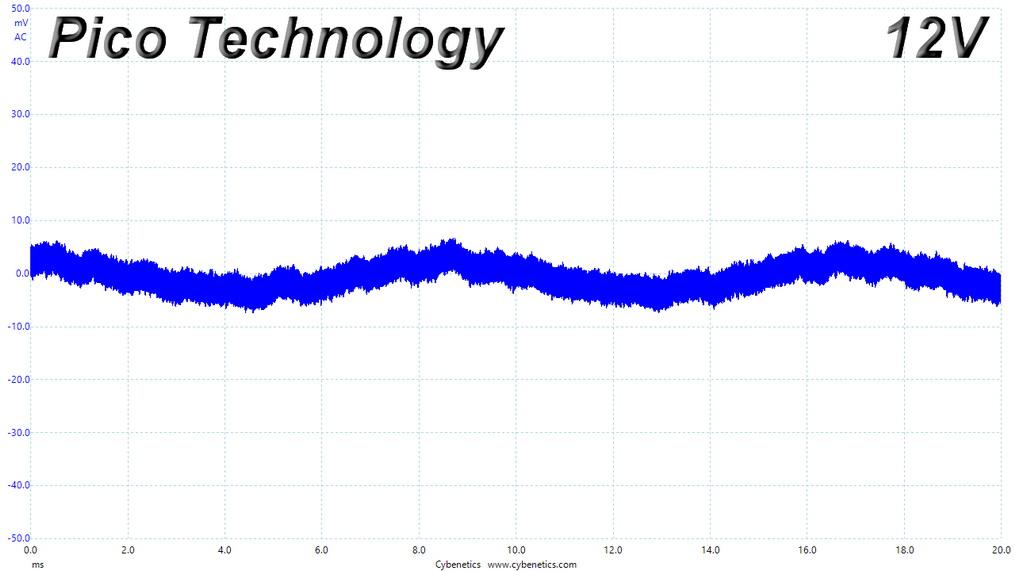
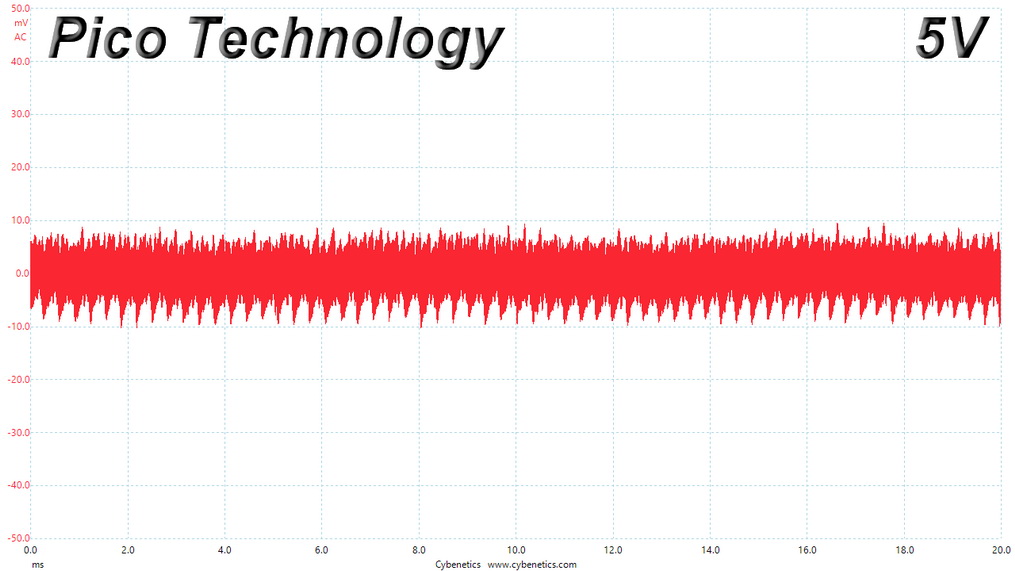


Ripple At Cross-Load 4




EMC Pre-Compliance Testing – Average & Quasi-Peak EMI Detector Results
Electromagnetic Compatibility (EMC) is the ability of a device to operate properly in its environment without disrupting the proper operation of other nearby devices.
Electromagnetic Interference (EMI) stands for the electromagnetic energy a device emits, and it can cause problems in other nearby devices if too high. For example, it can cause increased static noise in your headphones or/and speakers.
΅We use TekBox's EMCview to conduct our EMC pre-compliance testing.
Some peaks exceed the limits with the average EMI detector, but everything looks good with the peak EMI detector.
MORE: Best Power Supplies
MORE: How We Test Power Supplies
MORE: All Power Supply Content
Current page: Transient Response Tests, Timing Tests, Ripple Measurements and EMC Pre-Compliance Testing
Prev Page Protection Features, DC Power Sequencing, Cross-Load Tests and Infrared Images Next Page Performance, Noise, Efficiency and Power Factor
Aris Mpitziopoulos is a contributing editor at Tom's Hardware, covering PSUs.
-
Udyr So this is a 4 star product with 1, 2, 3, 4... 12 cons?Reply
The cons are somewhat consistent with the review on TPU, but over there it was not a recommended product.
Maybe there's something more my ignorant self is not seeing here. -
DRagor ReplyUdyr said:So this is a 4 star product with 1, 2, 3, 4... 12 cons?The Gigabyte UD1000GM PG5 is the first PSU available with a 12+4 pin PCIe connector, so practically, it doesn't have any competitors yet.
How it was? In the land of blind one eyed is a king? -
WrongRookie No thanks. I'd rather wait for Seasonic do one than get another one that could end up explodingReply -
Udyr Reply
I understand the reference, but in this case, a unit with these many downsides doesn't justify a recommendation, unless there's something else besides being the only one available (for now).DRagor said:How it was? In the land of blind one eyed is a king? -
thisisaname Reply
Some of the positives are not that great either.Udyr said:So this is a 4 star product with 1, 2, 3, 4... 12 cons?
The cons are somewhat consistent with the review on TPU, but over there it was not a recommended product.
Maybe there's something more my ignorant self is not seeing here.
+Full power at 47 degrees Celsius
+Most protection features are properly set -
watzupken Once beaten, twice shy. After the shady practice and persistent denial of critical flaws with their product by Gigabyte, even if this is a 5 stars PSU, I will not bother to consider it. There are much better options out there. I rather pay more than to deal with shady companies. In my opinion, it is not the product that we need to be mindful because every company will at some point produce bad product. It is how they take steps to resolve the issue and maintain that goodwill. Gigabyte basically burned that goodwill in the PSU fiasco. So no more Gigabyte products for me since the company can’t be bothered.Reply
